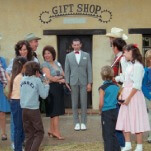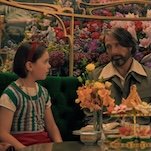Dracula: "Let There Be Light"

It’s hard to say what the creative discussion in the early days of developing Dracula were, but one would hope their intention was not to entirely defang the mystique of the story over the course of ten hours. Unfortunately, many times it felt like that was the case. While Dracula had its moments in the first few episodes, the second half of the season suffered from the fact that as time went on, this narrative approach to the character as an alternate energy magnate was, well, sucking the life out of the story. When you have a show about the most powerful vampire who ever existed, and weekly plots revolve around attending a board meeting, winning an art auction, organizing a hospital dance or trying to obtain a permit from the Board of Health, there’s a definite sense that something has gone wrong in the execution. (This affliction is also known as Phantom Menace Syndrome, where a world that has plenty of opportunities for excitement chooses to fixate on largely economic plot points.) It also didn’t help that most of the romances surrounding the show grew increasingly dull as the series went on, a series of love triangles bogged down in leaden dialogue.
However, to the show’s credit, as the third act took place it started to feel like the writers had come to the same conclusion, and decided to accelerate the timetable for everyone involved. Last week’s “Four Roses” was one of the more encouraging installments as Dracula finally threw up his hands in frustration and decided to go to direct war with the Order, letting his thralls paint the walls of billiard rooms with blood and allowing Van Helsing to pursue his own separate kidnapping agenda. And “Let There Be Light” builds on that momentum to give an explosive end to Grayson’s plan for economic supremacy, devastate the upper echelons of the Order of the Dragon and set an entirely new status quo between the main characters. It’s an exciting, well-designed hour—and one that unfortunately leaves one asking where this excitement was in the last few weeks.
A lot of that excitement stems from the fact that after too much dancing around Dracula and the Order wanting to bring each other down by means of economic warfare, both sides have pulled out all their resources. Dracula has brought nests across all of London, and the Order has called in all their huntsmen to purge said nests. This is the sort of thing you want to see in a show where Dracula’s waging war against an ancient order, where the latter can marshal forces from across the globe who practice different forms of war—a Maori huntsman with a scimitar, a blind Sicilian who uses a Vatican relic to locate nests through visions more suited to a planetarium. In these preparations and fight scenes the show feels engaging again, which is a feeling that’s been sorely lacking in talk of geomagnetism.
Indeed, the show’s embrace of “geomagnetic technology” proved to be a stone around their neck, largely because no one on the show seemed to have any interest in discussing its functionality or ramifications. “Let There Be Light” doesn’t do much to flesh out the topic past that point, and instead opts to focus on the pomp and circumstance surrounding the discovery. Once again, Dracula is prepared to demonstrate his resonator to a populace, and this time he’s going about it with all the showmanship of P.T. Barnum, with marching bands, lighting rigs around the block and a phonograph recording making the rounds. The carnival-like atmosphere surrounding the demonstration proves Dracula never considered the technology as anything other than a plot device, a move that made a lot of the discussion around its import ring hollow as time went on.
Similarly, the Order of the Dragon failed to catch on as the series went on, as despite some early personal ties they never evolved beyond being a batch of interchangeable old rich white guys. It gradually started to become interesting as Jonathan was pulled deeper into their inner circle—even taking their sacred blood oath last week—but that decision felt less about the Order and more a reflection of how betrayed Jonathan felt by Dracula’s schemes. Dracula worked best as a show when it was about personal stakes, and certainly Jonathan was batted around all season to the point that betraying Grayson seemed like the most logical thing to do. It was endemic of Dracula’s flaw: for all his talk about wanting to be human again, he had a keen disregard for virtually all humans.
Keeping friends close is a trick that Dracula failed to achieve all season, as Van Helsing’s had a similarly dramatic break. Thomas Kretschmann’s largely been left all season to seethe in the corner and caution that Dracula stick to the plan, and allowing him to become devious is a much better use of his talents—and a good sign for his future role as an Avengers: Age Of Ultron supporting villain. Having identified Browning as the man responsible for his family’s death and without faith Dracula can pull off their scheme, he literally shatters his alliance by destroying the formulas that allow the vampire to walk in sunlight, throwing vials and reagents against the wall as “Hall Of The Mountain King” plays on in his head. And if that’s not enough, when Renfield shows up he buries a knife deep in the other man’s gut, cockily saying that he’s taken away his ability to ever walk in sunlight.
This hidden rage is used to brutal effect when he confronts Browning in an abandoned house, having lured him there by abducting his children. It’s Dracula’s most effective execution of the Gothic horror tropes to date, as first he manages to get a metaphorical drop on Browning to explain his motivations and then a literal drop as he sends him into the cellar and rains the ransom money on top of him. He reunites the man with his children, but the minute the children emerge from the darkness and offer strangely distant greetings, it’s immediately obvious what’s happened—all the viewer can do his hold their breath and wait for the reveal. Van Helsing is exposed as being almost as horrific as his former partner, willing to transform innocent children into abominations for the purpose of inflicting the worst possible hell on Browning, and then setting the entire house ablaze to close the circle. Small wonder that after getting his vengeance, all he can do is offer the same raw scream he did all those years ago.








































